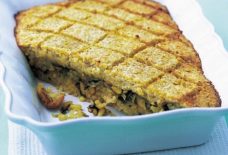Mediterranean Cooking from the Garden with Linda Dalal Sawaya: Savoy(a) cabbage for malfouf mihshi
malfouf mihshi siyemi (Lebanese stuffed vegan cabbage rolls) © linda dalal sawaya 2015
Savoy cabbage, my dear Iraqi friend Aseel recently told me in a joking way, is “Sawaya cabbage”. This because my Lebanese last name, Sawaya, is not an Arabic word; I am told the name comes from Savoy, the region of northern Italy and southern France that centuries ago arrived in the Levant via the Crusaders. Since there is no “v” in Arabic, the people were called “Sawaya” instead of “Savoya” or from Savoy. Not sure that I’m proud to have Crusader genes, but I do love Italy, and many Lebanese villages such as my parents’ Douma, look as though they could be Italian with their red-tiled roofs, armeed in Arabic. A classic Italian fall/winter recipe, verza stufata, uses savoy cabbage that is braised.
And so the cabbage I used to make stuffed vegetarian cabbage rolls didn’t grow in my garden, but came from an organic farm nearby, and it’s savoy cabbage. It is a very tender and delicately flavored cabbage, so I made malfouf mihshi siyeme, Lebanese vegan (or Lenten) stuffed cabbage rolls, rather than using typical green cabbage as did my mother, Alice. Savoy cabbage can replace regular green cabbage in most any recipe. Our Lebanese cole slaw is excellent with savoy.
salatat malfouf Lebanese cabbage salad © linda dalal sawaya 2015
Both the vegan and the lamb versions of this mihshi (stuffed dish) are spicy, lemony, and wonderfully flavorful for the cold winter nights of fall. In a couple of weeks we will be officially in winter in the northern hemisphere, and because I still have Italian parsley and spearmint in my garden, and I have not made this dish for a long time, it is high time to make it.
The cabbage leaves are wilted in a steaming water bath after removing the core of the head of cabbage. The wilted leaves are easily lifted off the head and placed into a strainer to cool, as the entire head gets unraveled one leaf at a time.
Savoy cabbage leaves wilted, vegetarian stuffing, savoy cabbage leaf ready to roll © linda dalal sawaya 2015
Once cooled and the stuffing (hashwe) has been made, each leaf is placed rib side down, and the thick central rib is removed. Outer leaves and leaves that are too small to stuff, along with the ribs are placed to line the bottom of a deep pot in which to cook the malfouf. This is a classic one-pot meal that Lebanese and other Levantine villagers developed to cook in their one-burner kitchens of the old days.
splitting and removing skins from garbanzo beans for stuffing © linda dalal sawaya 2015
The rice, garbanzo, and vegetable stuffing provides a nutritious and delicious roll not as well known as rolled grape leaves, yabra, but equally delicious. Surprisingly the most time consuming part of this recipe is preparing the garbanzo beans (hommous). Soaked overnight in water, they are then drained and rolled vigorously with a rolling pin in a towel to split them and remove their outer skin. Putting them into a pot of water facilitated separating the skins from the beans as they floated off the pouring water. Rice and beans make a complementary protein, while the parsley, mint, green onions, and celery provide flavorful nutrition.
layering cabbage rolls into pot © linda dalal sawaya 2015
One by one, the rolls are stacked on the bottom layer of leaves, while each additional row of rolls is placed perpendicular to the row beneath it. More seasonings are added to the pot plus garlic, olive oil, and lemon juice with water. A heavy plate is laid on top of the rolls to hold them in place. The cook time is about 90 minutes for the brown rice and garbanzos to cook thoroughly in the filling. The plate is removed midway through the cooking time. Once they are done, let them sit about 15 minutes in the pot before turning them upside down onto a platter, for a beautiful presentation garnished with lemon slices and parsley.
malfouf mihshi siyemi (Lebanese stuffed vegan cabbage rolls) © linda dalal sawaya 2015
I hope you enjoy your vegan Sawaya/savoya malfouf mihshi with family and friends this holiday season as a main course or for appetizers! They can be served hot, warm, or at room temperature, probably not cold at this time of the year. You can find the full recipe in Alice’s Kitchen: Traditional Lebanese Cooking. Sahtine and happy cooking!
—Linda Dalal Sawaya is a Portland artist, cook, Master Gardener, daughter of Lebanese immigrants, and author of Alice’s Kitchen: Traditional Lebanese Cooking
Remember, as my mother Alice said, “If you make it with love, it will be delicious!”
all photos and story © linda dalal sawaya 2015



